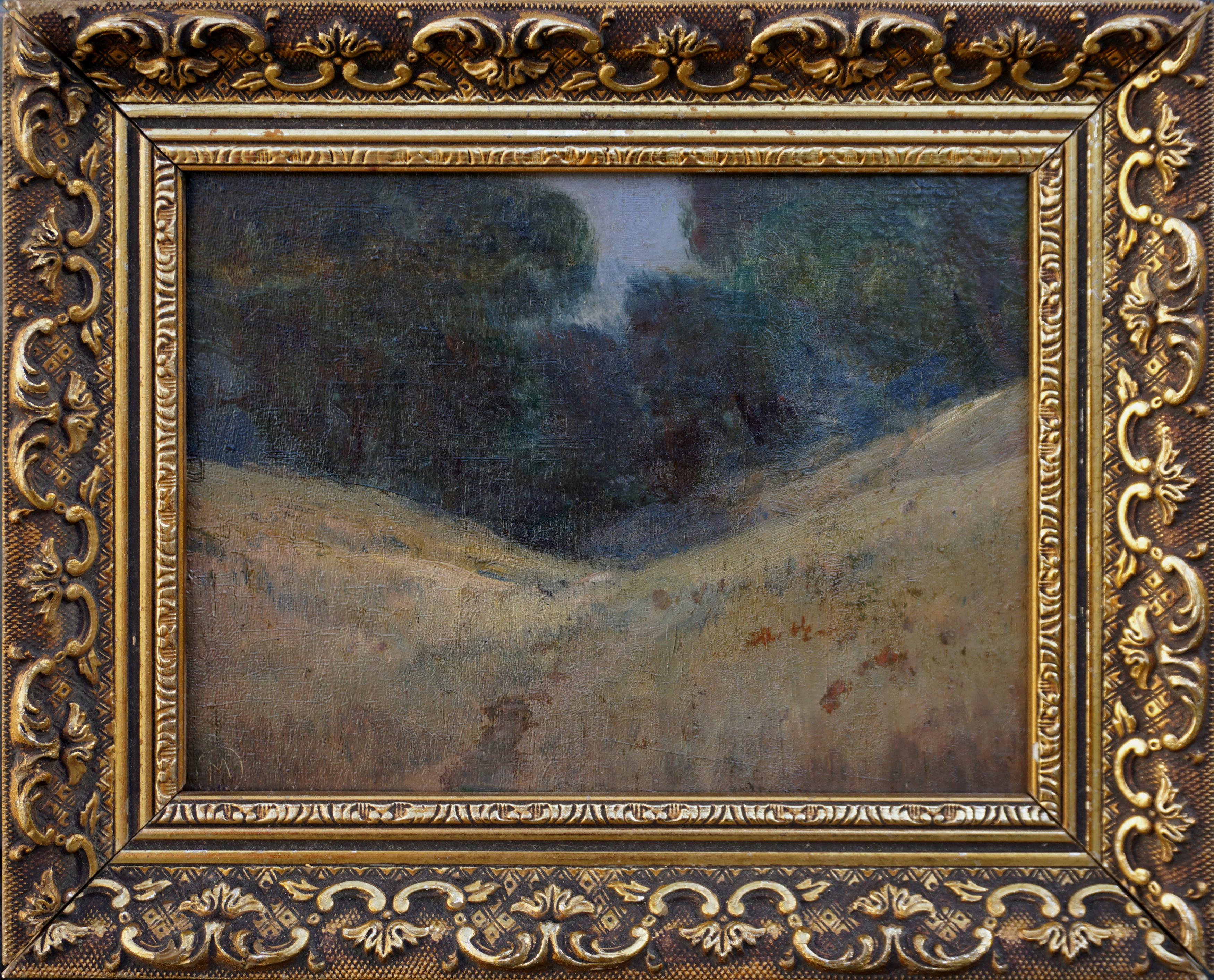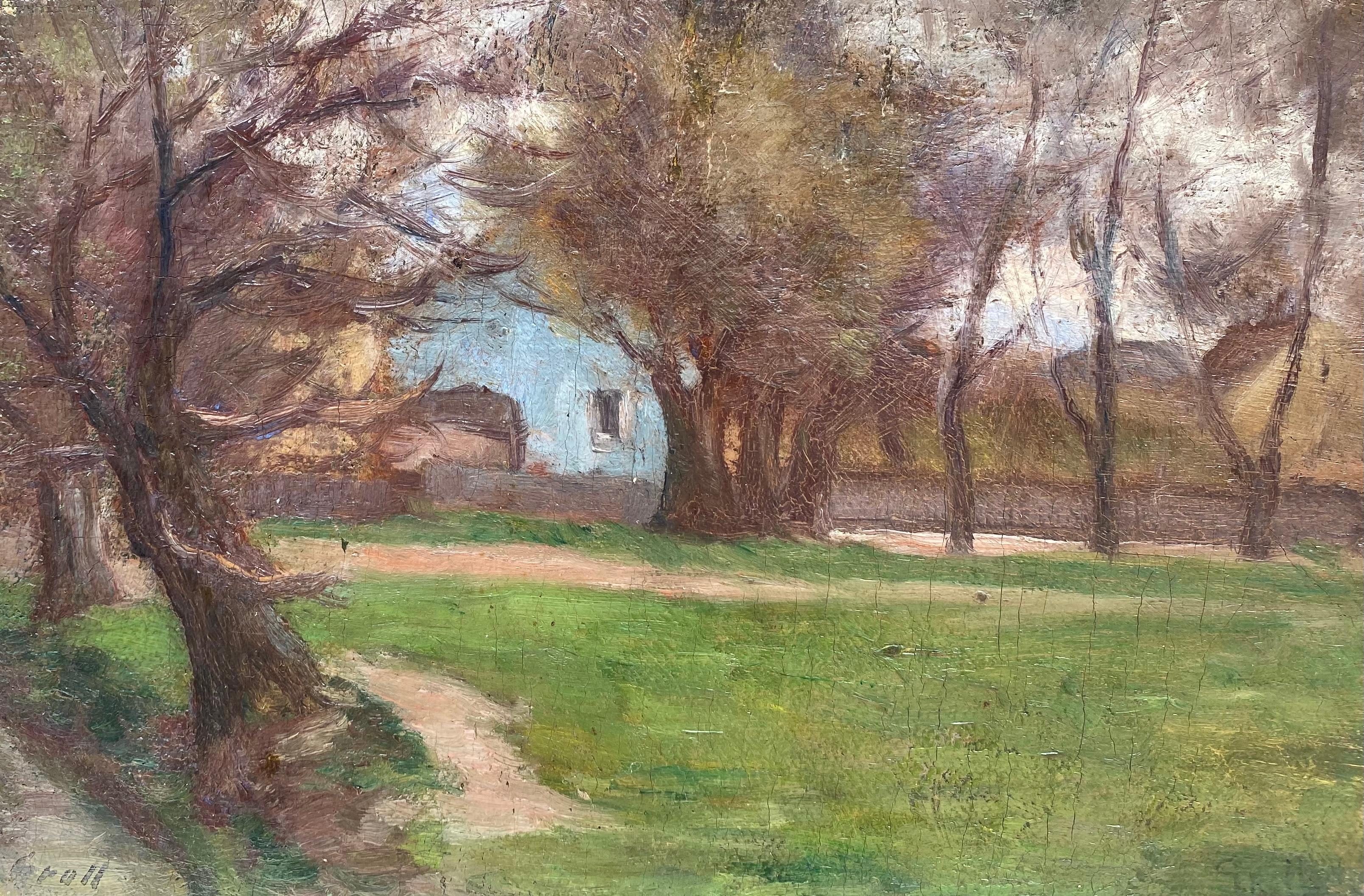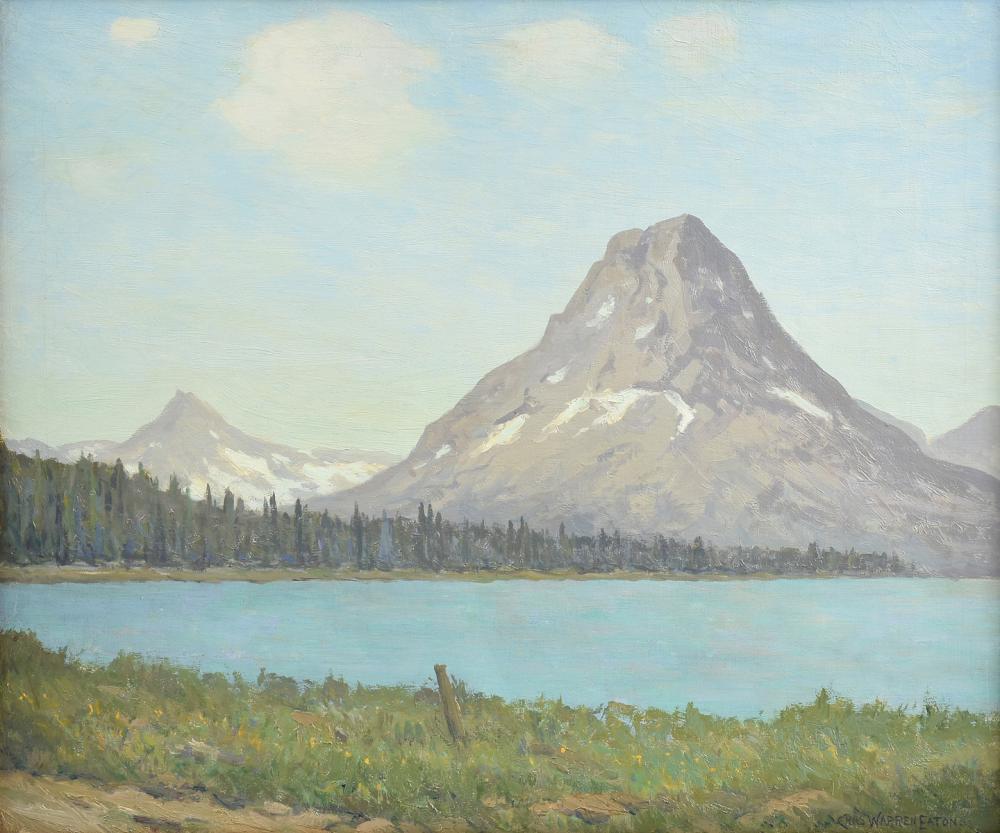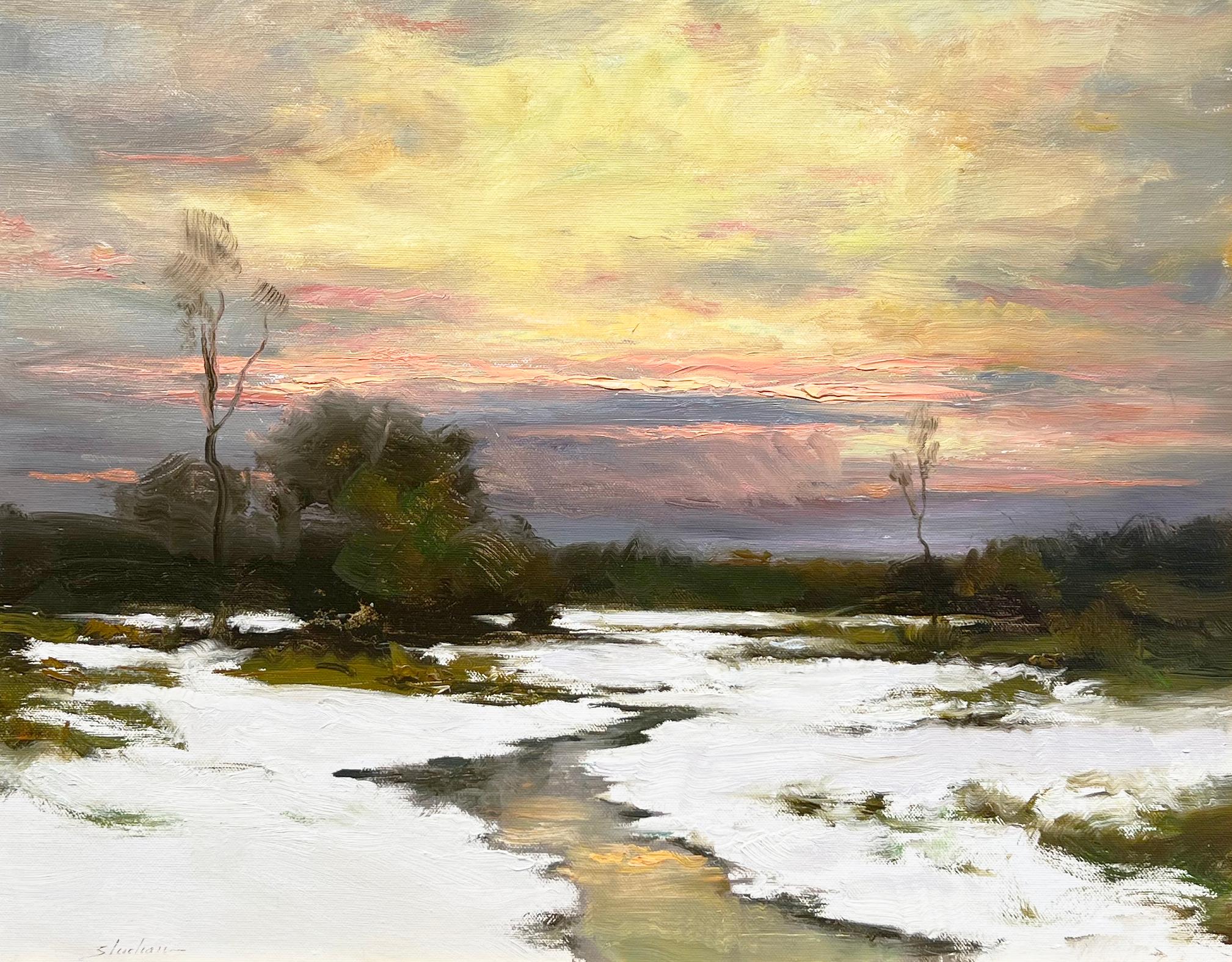Items Similar to 'Nymphs at Dusk', Art Nouveau, Arts and Crafts, Tonalist Oil, Three Graces, AIC
Want more images or videos?
Request additional images or videos from the seller
1 of 17
William Emerson'Nymphs at Dusk', Art Nouveau, Arts and Crafts, Tonalist Oil, Three Graces, AIC1910
1910
About the Item
Signed lower right, 'Emerson' for William C. Emerson (American, 1865-1937) and dated 1910.
Original card board, verso, was additionally signed 'W. C. Emerson' and titled, 'The Dance' (images included were taken prior to lay down).
Displayed in a period, carved and giltwood frame; framed dimensions: 27.75 x 33.75 x 1.5 inches.
Born in London, England, William Emerson was an accomplished architect and a widely-exhibited painter of tonalist landscapes. He was a member of the New York Watercolor Club, the Chicago Watercolor Club, the Chicago Society of Artists, and the Westchester Art Institute. Active in Chicago and New Preston, Connecticut, he also exhibited at the Chicago Art Institute. William Emerson is listed in all relevant art reference works including Who Was Who in American Art.
Reference:
Who Was Who in American Art 1564-1975: 400 Years of Artists in America, Peter Hastings Falk, Sound View Press 1999, Vol. 1, page 1042; Mantle Fielding’s Dictionary of American Painters, Sculptors and Engravers, Glen B. Opitz, Apollo Press 1983, page 277; Mallett’s Index of Artists, Daniel Trowbridge Mallett, Peter Smith: New York 1948 Edition, R.R. Bowker Company 1935, page
127; et al.
- Creator:William Emerson (1865 - 1937, American)
- Creation Year:1910
- Dimensions:Height: 22.25 in (56.52 cm)Width: 28 in (71.12 cm)Depth: 0.13 in (3.31 mm)
- Medium:
- Movement & Style:
- Period:
- Condition:painting: original card laid down on masonite; minor restoration, minor losses, minor craquelure, age-toning; frame: minor rubbing; shows well.
- Gallery Location:Santa Cruz, CA
- Reference Number:1stDibs: LU34411581322
About the Seller
5.0
Platinum Seller
These expertly vetted sellers are 1stDibs' most experienced sellers and are rated highest by our customers.
Established in 1982
1stDibs seller since 2013
639 sales on 1stDibs
Typical response time: <1 hour
- ShippingRetrieving quote...Ships From: Santa Cruz, CA
- Return PolicyA return for this item may be initiated within 3 days of delivery.
More From This SellerView All
- 'Sunset Landscape'By Carl WarrenLocated in Santa Cruz, CASigned lower right, 'Carl Warren' (American, 20th century) and painted circa 1975. A lyrical, tonalist landscape showing a view of softly-lit woods with a stand of pine in the foreg...Category
Mid-20th Century Tonalist Landscape Paintings
MaterialsCanvas, Oil
- 'Breaking Wave, California Coast', Tonalist Seascape, New York, SacramentoLocated in Santa Cruz, CASigned lower left, 'Pogacar' for Vincent Pogacar (American, 1929-1997) and painted circa 1985. A cabinet-sized study of ocean water breaking against b...Category
1980s Tonalist Landscape Paintings
MaterialsOil, Canvas
- 'Harbor Mist', Pasadena Art Museum, California, Post-Impressionist oilBy Jonathan ScottLocated in Santa Cruz, CASigned lower left, 'Jonathan Scott' (British, 1914-1995) and titled verso. Provenance: Nancy Moure, Glendale, California Jonathan Scott studied first at the Heatherly School in Lond...Category
1960s Post-Impressionist Landscape Paintings
MaterialsOil, Cardboard
- 'Sunset Over El Capitan', American Impressionism, Yosemite, California LandscapeLocated in Santa Cruz, CAInitialed lower left, 'C.B.' (American, 20th century) and painted circa 1925. Framed dimensions: 14 H x 11.75 W x 1 D inches N.B. The artist initials show more distinctly under (365n...Category
1920s Impressionist Landscape Paintings
MaterialsOil, Cardboard
- 'Montmartre, Place du Tertre', Paris, Woman Modernist, AIC, Smithsonian, CarmelBy Patricia Stanley CunninghamLocated in Santa Cruz, CASigned lower right, 'Patricia Cunningham' for Patricia Stanley Cunningham (American, 1907-1984) and painted circa 1965. The first woman to serve as president of the Carmel Art Assoc...Category
1960s Modern Landscape Paintings
MaterialsOil, Masonite
- 'Abstract Landscape', California College of Arts and Crafts, Oakland, ThiebaudBy Don ClausenLocated in Santa Cruz, CASigned lower left, 'Clausen' for Don Clausen (American, 1930-2020) and dated 1974. A self-proclaimed "sculptor of paint," Donald Clausen used tools of his own invention to create co...Category
1970s Abstract Abstract Paintings
MaterialsMasonite, Oil
You May Also Like
- Late 19th Century Tonalist Landscape with Oak TreesBy Willard LeRoy MetcalfLocated in Soquel, CAGorgeous late 19th century Tonalist landscape painting of foothills and oak trees in the style of Willard Leroy Metcalf circa 1900. Inscribed "M" in circle monogram lower left corner and on frame verso. Presented in original rustic giltwood frame. Image size: 6"H x 8"W. Framed size: 8.5"H x 10.5"W. Tonalist are usually intimate works, painted with a limited palette. Tonalist paintings are softly expressive, suggestive rather than detailed, often depicting the landscape at twilight or evening, when there is an absence of contrast. Tonalist paintings could also be figurative, but in them, the figure was usually out of doors or in an interior in a low-key setting with little detail. Tonalism had its origins in the works of the French Barbizon school and in the works of American painters who were influenced by them. California Tonalism was born when the emphasis in California landscape painting passed from the grand landscapes of works like those of Thomas Hill and William Keith's early career, to more intimate views of a domesticated landscape. At the same time, the parallel Pictorialist Photography...Category
1890s Tonalist Landscape Paintings
MaterialsOil, Cardboard
- Cattle By Pond At Dusk, Mid-19th Century Tonalist Landscape by William KeithBy William KeithLocated in Soquel, CACattle By Pond At Dusk, Mid-19th Century Tonalist Landscape by William Keith Gorgeous mid-19th century landscape painting by William Keith (American, 1838-1911), circa 1860. This impressive Tonalist landscape, titled "In the Woods", depicts cattle beside a pond in the forest at dusk. Keith uses loose, blended brush strokes and a muted earthy palette to create an atmospheric mood that Tonalism is known for. Signed "W. Keith" lower left. Museum label on verso from Santa Barbara Museum of Art. Presented in an antique giltwood frame. Image size: 9"H x 13"W. With frame measures: 16"H x 20"W x 3"D. Provenance: Mrs. Eugene Patterson; Santa Barbara Museum of Art. Authenticity guaranteed and certificate include. Condition: Very good. Cleaning and restoration required signature to be re-touched, original images pre-restoration available. About the Artist: Brought to New York City in 1850, William Keith was apprenticed to a wood engraver in 1856 working for "Harper's" magazine. In 1858 (or 1859) he visited California for "Harper's" and then after a trip to Great Britain, settled in California as an engraver in 1862. He began exhibiting paintings in 1864 in San Francisco where he opened his studio, after having been taught painting by his wife. The Northern Pacific Railroad...Category
Late 19th Century Tonalist Figurative Paintings
MaterialsCardboard, Oil
- “A Lovely Day”By Albert Lorey GrollLocated in Southampton, NYOil on canvas laid down on fiberboard by the American artist, Albert Lorey Groll. Signed lower left and in pencil lower right. Signed verso as well. Condition is good. Circa 1910. Sa...Category
1910s Tonalist Landscape Paintings
MaterialsCanvas, Oil, Fiberboard
- Misty Landscape: a Small Tonalist Work by Robertson Mygatt, 1915Located in Philadelphia, PARobertson K. Mygatt (American, 1862-1919) Misty Landscape Oil on panel, 7 7/8 x 9 7/8 inches Framed: 14 x 16 inches (approx.) Signed and dated at lower left: "Robertson K. Mygatt 19...Category
1910s Tonalist Landscape Paintings
MaterialsOil, Panel
- "Mount Rockwell, Glacier National Park, Montana, " Mountain Lake Landscape ViewBy Charles Warren EatonLocated in New York, NYCharles Warren Eaton (1857 – 1937) The Shadow of Mount Rockwell, Glacier National Park, Montana, 1921 Oil on canvas 20 x 24 inches Signed lower right: CHAS WARREN EATON. Provenance: The artist The Macbeth Gallery, New York Private Collection Sotheby's New York, American Art, April 14, 1989 ConocoPhillips, Houston Simpson Galleries, Houston, Fine Art & Antiques, May 18, 2019, Lot 447 Exhibited: New York, The Macbeth Gallery, Paintings of Glacier National Park by Charles Warren Eaton, December 13, 1921 - January 2, 1922, no. 2. Literature: "Two Exhibitions at Macbeth's," American Art News, New York, Vol. XX, No. 10, December 17, 1921. A contemporary critic wrote that the paintings of Charles Warren Eaton appeal to “the dreamers who find in them the undiscovered scenes in which their fancy long has dwelt.” Eaton’s contemplative landscapes exude a spiritual quality that moves the observer into a similar frame of mind. He loved to depict the ethereal light of dawn and dusk in late autumn or winter, usually without any reference to human or animal figures or buildings. These Tonalist paintings, with their subdued palette and relatively intimate scale, marked a definite break with the fading popularity of the panoramic and romantic views of the Hudson River School painters. Charles Warren Eaton was born in Albany, New York to a family of limited means. He began painting while working in a dry-goods store. At age 22, he enrolled at the National Academy of Design in New York City and then studied figure painting at the Art Students League. By 1886, he was successful enough to quit his day job and make a living as a landscape painter. That year, he traveled to Europe with fellow Tonalist painters Leonard Ochtman and Ben Foster. In France, Eaton visited popular artist’s spots such as Paris, Fontainebleau and Grez-sur-Loing, and fell in love with the loose brushwork and moody style of French Barbizon painting. Returning to the United States, Eaton fell under the spell of George Inness, the foremost exponent of Barbizon style in the United States. In 1888, Eaton settled near Inness in Bloomfield, New Jersey, where Eaton lived until his death in 1937. In this period, he painted shadowy and ambiguous landscapes inspired by rural scenery in the northeastern United States. His signature theme was a cropped view of the branches, trunks, and foliage of a pine grove silhouetted against a delicately illuminated sunset or moonlit sky. He painted this vision so often between 1900 and 1910 that he picked up the sobriquet ‘‘The Pine Tree Painter.” After 1910, Eaton responded to the popularity of Impressionism by using brighter colors and painting sunlit daytime scenes. In 1921, he was hired to paint Glacier Lake, in Glacier National Park by the Great Northern Railroad Company as part of their ‘See America First’ campaign. He produced more than 20 paintings, among the artist's last works, that now poignantly remind viewers of the vast disappearing glaciers. Eaton tended to approach this mountain scenery from an oblique vantage point; he liked to capture small episodes, showing mountaintops nearly obscured by dramatically attenuated screens of fir trees. Eaton, like many Tonalist artists of his generation such as Henry Ward Ranger, John Francis Murphy, and Charles Melville Dewey...Category
1920s Tonalist Landscape Paintings
MaterialsCanvas, Paint, Oil
- Dennis Sheehan, "Winter Dusk", 16x20 Snowy Landscape Tonalist Oil PaintingBy Dennis SheehanLocated in Saratoga Springs, NYThis piece, "Winter Dusk", is a 16x20 winter landscape oil painting on canvas by artist Dennis Sheehan. Featured is view over a snow covered marshland during the evening hours. The w...Category
2010s Tonalist Landscape Paintings
MaterialsCanvas, Oil
Recently Viewed
View AllMore Ways To Browse
Craft For Art
Art Nouveau Original Art
American Art Nouveau
Art Nouveau Framed
Art Painting Nouveau
The Graces
Arts And Crafts Landscape Art Paintings
Arts And Crafts Art Nouveau
Art Nouveau Display
Art Et Craft
Antique Frames Chicago
William A Smith
Mantle Art
Art Nouveau Oil
Art Nouveau Oil Painting
Nouveau Oil Painting
Antique Nymph
Peter Smith





